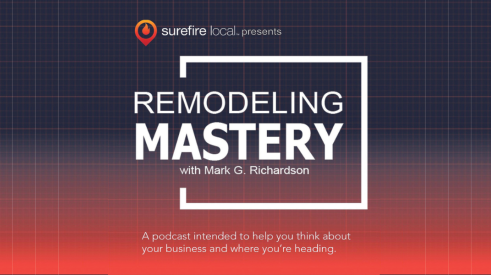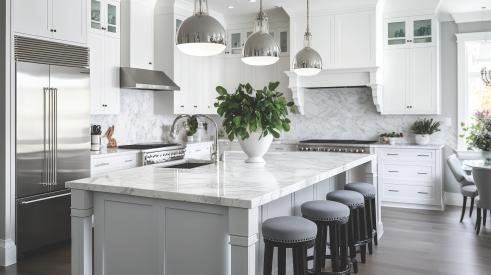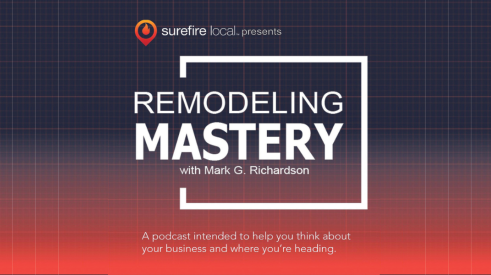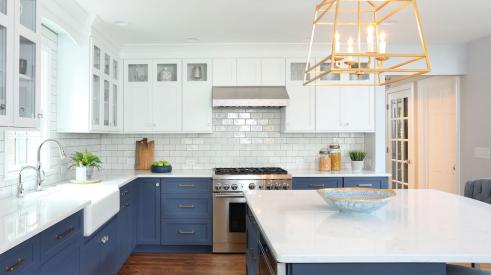| Mike and Katherine Shumate carefully plan advertising strategies to target legitimate customers for their Carlsbad, Calif.-based Complete Design and Remodeling business.
|
For Mike Shumate, CGR, of Carlsbad, Calif.-based Complete Design & Remodeling, good advertising isn’t about finding people who might be interested in his business -- it’s about finding business he wants.
"I’m a different animal than the other remodelers out there, and we seek to distinguish ourselves from our competitors. We can do major alterations and whole house renovation projects as well as kitchens and baths...our product is wholesale, and we offer a service level that can’t be had out of Home Depot," he says. "Our ideal customer is someone who wants us to take care of them."
Located in the highly competitive remodeling market of the San Diego-metropolitan area, Shumate carefully plans his advertising strategies to target good prospects that turn into legitimate leads. Although his marketing efforts do take up a significant portion of each work week, he spends less time chasing leads and submitting bids for clients who aren’t serious about their projects. "The objective of the ad program is to produce good leads. The better the lead, the better chance you have of getting a sale. We want to be the only person prospective clients are talking to, and we want to show them the value we offer."
Realizing the benefits of targeted advertising didn’t come to Shumate overnight. "You have to identify the niche market you want, and it took me more than two years to figure that out," he says. For Shumate, the decision to expand his advertising program came hand in hand with the decision to expand his business.
| Complete Design & Remodel
Location: Carlsbad, Calif. Type of company: Full service design/build remodeler Staff model: 6 office, 15 field Annual jobs: 50 Sales history: $1.2 million in 1998, estimated $2.5 million in 2000 Work week: 60 hours Software: 20/20, Circle 239; Chief Architect, Circle 238; ISS, Circle 237; Microsoft Office, Circle 236 Bio: Shumate holds a degree in management from California State University, Sonoma, and has designed and remodeled projects in the San Diego area since 1977. Key to success: "Deal fairly with everyone on both sides of the equation, both customers and employees. I do quality work, and I work hard." Contact: cdr@pacbell.net |
In 1995 Shumate and his wife and partner, Katherine, decided to open a showroom to augment their remodeling business. "We made a transition from a construction office to an actual business," he says. "We knew we wanted to expand, and one part of that was to open and stock a showroom. Therefore we made a commitment to that, and we needed to have enough business to justify the showroom."
In order to keep the leads coming in, the Shumates had to step outside of traditional referral-reliant sales efforts. From the beginning, they eschewed Yellow Pages advertising. "This is a large area, and there’s a lot of competition here," says Shumate. "Yellow Pages ads have never worked for me -- they’re a waste of money in my market. People don’t look in the Yellow Pages for general contractors, and very rarely do [those prospects] prove to be good leads."
Instead, the Shumates began developing a strategy for effective print advertising. Beginning their research with local newspapers, the Shumates set out to find the best compromise between advertising costs and reaching their target audience. Instead of taking out less-frequent ads in a variety of papers, or taking on the expensive contract for a weekly ad in a major section of the primary San Diego-area paper, they opted to advertise in the local paper''''''''s advertising insert. The four-color inserts differ for each of the eight different marketing areas in San Diego, and only one ad from each type of trade is accepted for each version. Shumate purchases half-page ads in two different markets each week, covering the entire region in a month. These ads are read by interested prospects, and aren’t surrounded by competitor’s ads, because of their placement in the paper.
The original purpose for the newspaper ads was to build name recognition. "Our primary effort is to let people know the professional level of our company. We identify ourselves as a full-service design/build company and we augment that with the professional qualifications we have." All print advertisements are created in-house by a dedicated graphic designer.
| Advertising Budgets for Dummies
Mike Shumate uses a simple formula for figuring out his yearly and monthly advertising budgets. He recommends that remodelers allocate about 5 percent of their anticipated total business for the year toward advertising. After you estimate your yearly advertising total, prioritize your advertising requirements. Many newspaper and radio advertisements are discounted for yearly contracts, so allocating funds for these media at this stage in the budget is easiest. In Shumate’s case, he allocates for radio ads first, then newspaper ads, because the yearly contract for radio must be fixed far in advance. Newspaper contracts are also pre-planned, but are also more flexible than radio. The remaining advertising budget is used to host seminars and meet any additional advertising needs. Advertisement commitments are then divided up by month, according to need, and accounted for in any necessary monthly report. Complete Design & Remodeling Radio advertising = $5,000/month |
But the focus of the newspaper advertising has become two-fold since Shumate has expanded into other types of advertising. Now, the print advertisements complement Shumate’s two additional advertising media: live seminars and radio broadcasts.
Since November 1999, the Shumates have served as experts and radio personalities for a local AM radio talk show, "Let’s Talk Remodeling." Katherine was originally approached to do the show as a result of her seminar program. After her first male co-host didn’t work out, Mike was invited to join her full-time.
The two-hour program airs on Sunday nights and provides information for locals on remodeling and design. The Shumates also field related questions from callers. Through the radio program, the Shumates garner additional name recognition for their company as well as a discount rate for weekly advertising on the station. Shumate estimates that one single prime-time advertisement on the station reaches about 50,000 listeners. The advertisements aired by the Shumates are geared toward drawing potential customers to the company’s other primary marketing medium, bi-monthly seminars.
Twice a month, Katherine holds a free seminar sponsored by Complete Design & Remodeling. The seminars provide locals with information they need to plan for a kitchen or bath remodel, including an information packet designed to help customers choose products.
| Community Outreach
Remodeling seminars are the Shumates’ best opportunity to target key customers. By offering a course to prepare homeowners for a home remodel, not only do they begin building customer relationships before any type of sales meeting, but they also educate those customers to identify their own needs. The Shumates hold seminars every six weeks. The three-hour sessions are held once a month on a weekend in the Shumates’ showroom facility and once a month during a weeknight in a restaurant conference room, to reach homeowners of varying schedules. Run by Katherine Novo-Shumate, the courses help customers identify their own desires and compile a list of needs that can be clearly communicated to a remodeler. "We give them all the information they need to deal with a contractor or a supplier," says Mike Shumate. "It serves a twofold purpose -- it educates the customer and gives them the tools they need to know. If they do come in and work with us, we can then move through the process much faster." Katherine began holding seminars in 1992, while working for another company. With a background in design and business instruction, she’s able to make the seminars entertaining as well as useful. Mike brings technical expertise to the sessions. On average, each session requires about an hour of preparation in addition to the three hours for presentation. The Shumates spend an average of $250 to hold each session, not including promotion. Mike Shumate figures that the seminar program results in a $100-per realistic-lead expense. "The more information you can get into the hands of the public, and the easier you can make their choices, the faster you can process their project," he says. |
The leads garnered from the sessions are much more likely to hire the Shumates for remodel projects. "Although we don’t get everyone, fully 50 percent of the attendees come in to do business with us, sooner or later. The other 50 percent are armed and dangerous [with our information]," says Shumate. He estimates that approximately 20 people attend each session.
To meet the challenge of using different media together, Shumate must plan far in advance. A separate advertising budget and schedule is drawn up at the beginning of the year and followed strictly. Because advertising dollars don’t have a direct return, budgeting for multiple advertising investments can become tricky. "I have to figure out where the money is coming from," says Shumate. "It’s something I pay close attention to, because it’s an expense that’s unrelated to operations. It’s not like I’m spending that money on lumber for a job. It doesn’t bring you anything."
To effectively track the success of any advertising investment, Shumate stresses that remodelers must observe their incoming leads over no less than six months. "Advertising is a long-term process," he says. "Unless you’re selling widgets, and someone wants that widget right now, your advertising won’t have an immediate impact."
Homeowners looking to remodel often cut out Shumate’s ads and keep them on a refrigerator or message board for months while they begin the planning process on their own. "In this business, speed is a very important thing. Remodeling is not an impulse buy, and you can’t get customers instantly," he says. "We have people who have attended the seminar nine months ago who are just now coming in."
Add new comment
Related Stories
How to Get More Leads with a Stronger Remodeling Brand
Discover how to build a strong brand for your construction company, and learn key strategies to differentiate and attract better leads
How to Increase Your Odds of Closing Remodeling Sales
Use these tips to hone your sales process and grow close ratio
Building A Small Projects Division from the Ground Up
Through hard work and careful strategy, Harth Home Services has seen big growth
A Mindset of Serving Others
A research study shows surprising results about what makes us take ownership of our work.
10 Questions to Identify Sales Weaknesses
Mark Richardson runs you through a proper fitness check-up—for you and your sales team, that is.
How to Communicate with Today's Cautious Remodeling Client
Amid economic skepticism, Americans continue to spend. Now, how can you get them to spend on remodeling?
7 Tips to Lower Remodeling Costs
As material and labor prices spiral out of control, many homeowners are putting the brakes on remodeling projects. Use these guidelines to bring down costs.
How to Ease Client Fears and Take Control of the Remodeling Process
Industry advisor Mark Richardson offers seven ways to control your client's fantasy of remodeling and, ultimately, minimize their fears and enhance their understanding
3 Things I Learned from a Day with Normandy Remodeling
How Normandy uses numbers to motivate and the power of their showrooms
Today’s Consumer is Your Biggest Competitor
Understanding the real competitor allows you to sharpen the correct skills












